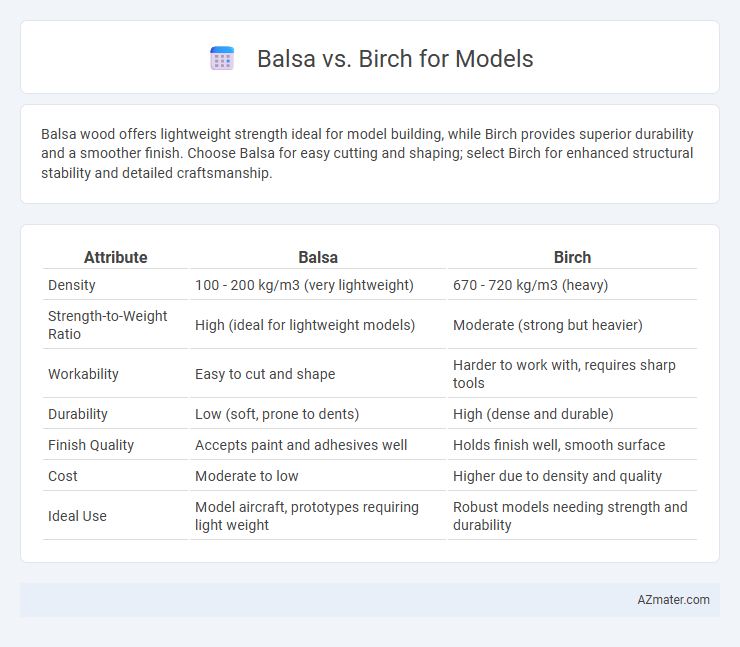Balsa wood offers lightweight strength ideal for model building, while Birch provides superior durability and a smoother finish. Choose Balsa for easy cutting and shaping; select Birch for enhanced structural stability and detailed craftsmanship.
Table of Comparison
| Attribute | Balsa | Birch |
|---|---|---|
| Density | 100 - 200 kg/m3 (very lightweight) | 670 - 720 kg/m3 (heavy) |
| Strength-to-Weight Ratio | High (ideal for lightweight models) | Moderate (strong but heavier) |
| Workability | Easy to cut and shape | Harder to work with, requires sharp tools |
| Durability | Low (soft, prone to dents) | High (dense and durable) |
| Finish Quality | Accepts paint and adhesives well | Holds finish well, smooth surface |
| Cost | Moderate to low | Higher due to density and quality |
| Ideal Use | Model aircraft, prototypes requiring light weight | Robust models needing strength and durability |
Introduction: Balsa vs Birch in Model Making
Balsa wood and birch are popular materials in model making, each offering unique advantages based on their properties. Balsa is favored for its lightweight nature and ease of cutting, making it ideal for intricate, delicate models and prototypes requiring minimal weight. Birch, on the other hand, boasts greater hardness and strength, providing durability for models that demand structural integrity and fine finishing.
Material Properties Comparison
Balsa wood, known for its exceptionally low density and high strength-to-weight ratio, provides superior buoyancy and lightweight characteristics ideal for model airplanes and boats. Birch, denser and harder than balsa, offers greater durability and fine grain finish, making it suitable for structural components requiring higher impact resistance. When choosing between balsa and birch for modeling, consider balsa's flexibility and ease of cutting against birch's robustness and smooth surface quality.
Weight and Density Differences
Balsa wood stands out for its ultra-lightweight properties, with a typical density ranging from 100 to 200 kg/m3, making it ideal for model aircraft and lightweight structures where minimal weight is critical. Birch exhibits a significantly higher density, typically around 600 to 700 kg/m3, offering greater strength and hardness but adding considerable weight compared to balsa. Selecting between balsa and birch depends on balancing the need for lightweight performance versus structural durability in model construction.
Strength and Durability
Birch wood offers superior strength and durability compared to Balsa, making it ideal for models that require robust structural integrity and long-lasting performance. Balsa is notably lightweight with moderate strength, favored for applications where ease of shaping and minimal weight are critical but less so for high-stress durability. Engineers and hobbyists often choose Birch for load-bearing parts due to its dense grain and resistance to wear, while Balsa serves well in aerodynamic sections needing low mass.
Workability and Ease of Cutting
Balsa wood is prized in model-making for its exceptional workability, being incredibly lightweight and soft, which allows for effortless cutting with basic tools and minimal effort. Birch, while denser and harder than balsa, offers a smoother finish but requires sharper blades and more precision to cut cleanly, making it less ideal for intricate or rapid model construction. Model builders favor balsa for ease of shaping and speed, whereas birch is chosen when durability and a fine surface are more critical.
Surface Finish and Paintability
Balsa wood offers a smooth surface finish with a lightweight structure ideal for detailed modeling, yet its porous texture requires thorough sanding and sealing before painting to achieve uniform coverage. Birch provides a finer, denser grain that results in a naturally smooth surface, enabling superior paint adherence and a more polished finish with less preparation. Model makers often prefer birch for its durability and paintability, while balsa is chosen for ease of shaping despite the extra effort needed for an optimal painted surface.
Cost and Availability
Balsa wood is generally more expensive than birch due to its lightweight properties and limited growth regions, making it a preferred choice for model enthusiasts requiring high strength-to-weight ratios. Birch is more widely available and cost-effective, benefiting from extensive commercial timber production, which makes it suitable for budget-conscious model builders. The choice between balsa and birch often hinges on balancing the cost with the specific needs for weight and durability in modeling projects.
Best Applications for Balsa
Balsa wood, known for its exceptional lightweight and softness, is ideal for model airplanes, architectural models, and lightweight prototypes where minimal weight is crucial. Its high strength-to-weight ratio allows for easy cutting and shaping, making it perfect for detailed model work requiring precision and flexibility. In contrast, birch, being denser and harder, is better suited for structural parts or models requiring greater durability rather than extreme lightness.
Best Uses for Birch
Birch wood is ideal for model-making projects requiring durability and fine detail due to its tight grain and strength compared to balsa's softness. It excels in structural components or scale models that demand sturdiness while maintaining a smooth finish for painting and gluing. Birch is preferred for architectural models, furniture prototypes, and mechanical parts where precision and resilience are critical.
Choosing the Right Wood for Your Model
Balsa wood is ideal for model building due to its lightweight and easy-to-shape properties, making it perfect for intricate designs and quick assembly. Birch wood offers superior strength and durability, suitable for models requiring more structural integrity and fine detail work. Assessing the project's weight, strength requirements, and finishing preferences is crucial when choosing between balsa and birch for model construction.

Infographic: Balsa vs Birch for Model
 azmater.com
azmater.com